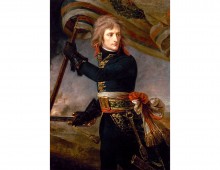Tagged with Art
Resource : Sir Joshua Reynolds’ portrait of Sir Banestre Tarleton
This portrait shows the flamboyant and controversial figure Sir Banestre Tarleton, a cavalry officer best known as commander of the ‘Tarleton Raiders’ during the American war of independence. It was painted by Sir Joshua Reynolds, the leading British portrait painter of the 18th century. Reynolds was a founding member of the Royal Academy and its first President, and was knighted by King George III.
Resource : The death of Marat by Jacques-Louis David
Jacques-Louis David (1748-1825) was the best-known painter of historical scenes of his generation. He was a strong supporter of the French Republic and effectively became its official artist. His painting, The Death of Marat, is one of the great propagandist images of the French Revolution.
Resource : The Blessings of Peace or the Curse of the Corn Law
This satirical cartoon, by George Cruikshank, is a comment on what became known as the Corn Laws – one of the most unpopular pieces of legislation ever to be introduced by the British Government.
Resource : Tolpuddle Martyrs Sculpture
In 1834, six farm workers were arrested and transported to Australia as a result of banding together to improve the miserable wages of farm labourers. The maltreatment of the ‘Tolpuddle Martyrs’, as they became known, helped pave the way for the creation of trade unions and the protection of employees’ rights.
Resource : The arts in the Age of Revolution
The works of Mary Shelley, Robbie Burns, Ludwig van Beethoven and George Stubbs to name a few, the Age of Revolution left a magnificent legacy of music, poetry, literature and art and still inspires the creative arts today.
Resource : Bust of Jean-Jaques Dessalines (1758 – 1806)
Jean-Jacques Dessalines (1758 – 1806) was born into slavery in St Domingue (now Haiti) on the Caribbean island of Hispaniola. Following a mass uprising of enslaved people of African origin – the only successful slave revolt in history – and a series of bloody battles and reprisals, Dessalines eventually became the first ruler of Haiti, the world’s first modern independent ‘black’ republic. The events in St Domingue became known as the Haitian Revolution.
Resource : Toussaint Louverture, Chief of the French Rebels in St Domingo
Toussaint Louverture (1743 – 1803) was born into slavery in St Domingue (now Haïti) on the Caribbean island of Hispaniola. In 1791 he led the first – and only – successful uprising of enslaved Africans. Although he died before the revolution spawned a nation, in 1804 Haiti became the first independent ‘black’ republic and contributed to the decline of the transatlantic slave trade. The events in St Domingue became known as the Haitian Revolution. This and other depictions of Louverture (in print and portraiture) reflected the high levels of fascination and respect expressed around the world for a radical figure who had refused to yield and who surmounted all foes in the revolutionary contests.


